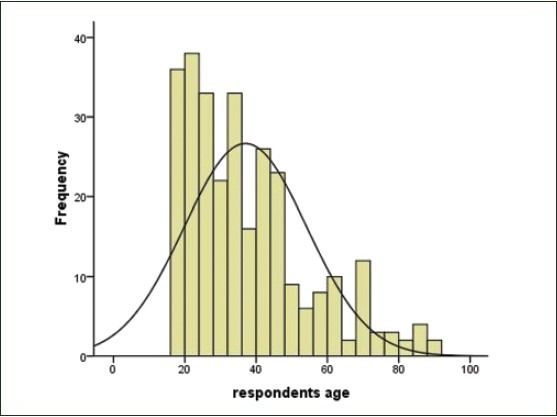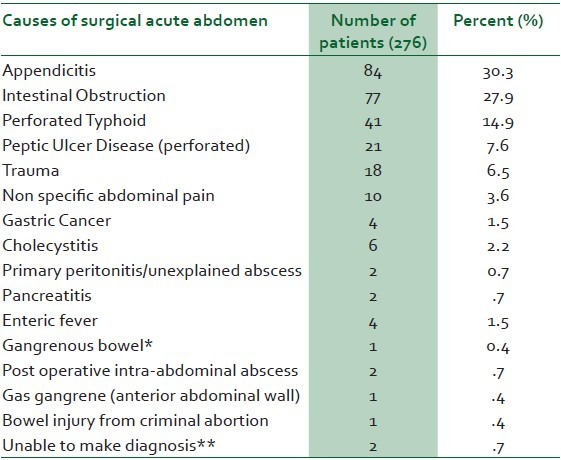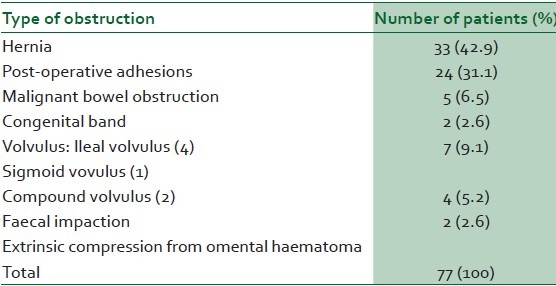Abstract
Background:
Abdominal pain of sudden onset is the hallmark of most non-traumatic emergency surgical presentations. This presents a scenario of urgency to the young surgeon who has to determine which of a myriad of disease conditions the patient is presenting with. Such a physician has to rely on experience and a sound knowledge of the local aetiological spectrum in making a clinical diagnosis.
Objective:
To determine the epidemiology and aetiological spectrum of diseases presenting as acute abdomen in the adult population at the hospital surgical emergency unit.
Patients and Methods:
Two hundred and seventy-six patients presenting at the University of Ilorin Teaching Hospital emergency unit and managed by the general surgeons between 1st of May 2009 and 30th of April 2010 were recruited and followed-up throughout the period of admission. The biodata and clinical information inclusive of diagnosis, investigations, treatment modality and outcome were entered in a structured questioner. Standardised treatment was given to all patients and difficulties encountered in their management were also noted. The data collected was evaluated using SPSS16.
Results:
Acute abdomen constituted 9.6% of total surgical emergency admissions with patients aged 16-45 years constituting 78.3%. The commonest cause of acute abdomen was appendicitis (30.3%) followed by intestinal obstruction (27.9%), perforated typhoid ileitis 14.9% and peptic ulcer disease (7.6%), respectively.
Conclusion:
The result from the study is similar to what has been reported in other tropical settings with inflammatory lesions being the major problem. There is also a rising incidence of post-operative adhesions and gradual decline in incidence of obstructed hernia.
Keywords: Abdominal pain, acute abdomen, pattern, peritonitis
INTRODUCTION
Acute abdomen may be defined as “An abnormal condition characterised by sudden onset of severe pain within the abdominal cavity which requires immediate evaluation, diagnosis and may require surgical intervention”.1 To the surgeon, a myriad of diseases may cause acute abdomen and it becomes necessary to determine which of these the patient is presenting with. It has been observed that when faced with a patient with abdominal pain, physicians rely on experience and a sound knowledge of the local aetiological spectrum.2
We noted that no similar study had been done in this hospital to document the aetiological spectrum of diseases presenting as acute abdomen in the adult patient at the surgical emergency prior to the time of this study. An earlier study by the paediatric surgery unit revealed various causes of acute abdomen in children presenting at the hospital.3 It therefore became imperative to conduct a similar study in the adult population.
It was hoped that such a study would highlight the current epidemiology of acute abdominal emergencies in Ilorin and its environs. The dynamics of acute abdominal emergencies keeps changing according to Ajao.4 This was confirmed barely 20 years after his findings at Ibadan by Irahbor et al.,5 who reported a definite change in the aetiology of Intestinal obstruction at same centre.
PATIENTS AND METHODS
This was a prospective, descriptive study carried out at the University of Ilorin Teaching Hospital (UITH) from May 2009 till April 2010. UITH is situated in Ilorin, the capital city of Kwara State in Nigeria.
All consenting patients aged 16 years and above presenting with acute abdomen to the surgical emergency were included in the study. Patients who discharged themselves against medical advice or declined to participate in the study and patients with gynaecological or non-surgical abdominal conditions were excluded.
All patients who met the inclusion criteria had their demographic data, presenting symptoms, findings on physical examination, diagnosis at admission, investigation results, findings at surgery, post-operative diagnosis and outcome of treatment, entered into a structured questionnaire. A diagnosis of ‘non-specific abdominal pain’ (NSAP) was recorded when no cause for the abdominal pain was found.6
Data analysis was done using the statistical package for social sciences (SPSS 16) and the results were summarised using statistical tables, graphs and charts as appropriate.
RESULTS
Two hundred and seventy-six patients who met the inclusion criteria were recruited during the study period. This constituted 9.6% of total surgical emergency admissions (2,875).
The patients’ age ranged from 16 to 90 years, 78.3% of the patients were aged 18- 45 years while those aged 16-25yrs constituted the peak age-group. The patient distribution according to age in years has a binomial distribution pattern [Figure 1].
Figure 1.

Showing the binomial distribution of the respondents age
One hundred and ninety-seven (71.4%) patients were male while 79 patients (28.6%) were female (M: F=2.5:1). In the younger patients (<45) there were three times more males presenting with acute abdomen than females. This ratio decreased with increasing age e.g., 10 patients (3.6%) were above 75 years with M: F = 1:1.
Most (60.2%) of the patients had secondary or tertiary education. 28.6% were students still in school while a notable portion (39.8%) of the patients had little or no form of formal education. The occupations of the patients are as shown in Table 1.
Table 1.
Occupation of the patients

Abdominal pain was the commonest presenting symptom (98.2%). This was followed by vomiting (68.5%), anorexia (56.9%) and fever (47.8%). One hundred and two patients (37.0%) were found to be dehydrated on admission while 16 patients (5.8%) were admitted in shock and needed to be resuscitated.
Eighteen patients (6.5%) had abdominal trauma of which gunshot injury and road traffic injury were mainly responsible. There was no presentation of stab wound to the abdomen during this period Table 2.
Table 2.
Causes of trauma to the abdomen

One hundred and fourteen patients (41.3%) had either used antibiotics or been hospitalised elsewhere before presenting to UITH Ilorin while 67 patients (24.3%) had previous similar illness.
There were 31 patients (11.2%) with comorbidities and the modal comorbidity was HIV (8 patients, of which four had been on highly active anti-retroviral drugs (HAART). Hypertension was present in seven patients (2.5%). Others included asthma (five patients, 1.8%), peptic ulcer disease (four patients, 1.5%), and three patients had diabetes mellitus.
Forty-four (15.9%) patients had had previous abdominal operation. Of these, 20 (51.3%) had laparotomy for unspecified reasons. Of the remaining patients, six (15.4%) had previous appendectomy and five (12.8%) had previous herniorrhaphy. Eight (19.9%) had previous gynaecological procedures. Septic abortion and its complications made up 64.3% of previous gynaecological procedures.
One-fifth of the patients presented on the day of onset of symptoms. More than half of the patients (51.8%) presented within 3 days (72 hours) of the onset of symptoms. By the seventh day of onset of symptoms, 78.3% of the patients had presented at the hospital. Further analysis of type of lesion and time of presentation showed that patients with obstructive symptoms were found to present within 24 hrs of onset (36.8) while many of the patients with perforated viscus presented in the second week of illness (58%). This was statistically significant P = 0.002.
The patients were categorised according to diagnosis [Figure 2]. Patients with inflammatory lesion comprised 34.1% of all patients with acute abdomen. Perforated viscus (29.7%), obstructive lesion (27.9%), haemorrhagic lesions (2.5%) and biliary colic 1.3%, 4.5% of the patients were classified as non-specific abdominal pain since no definitive diagnosis.
Figure 2.

Type/Classification of lesions managed for acute abdomen
A summary of the causes of surgical acute abdomen as seen within the study period at the surgical emergency unit of UITH Ilorin is shown on Table 3.
Table 3.
Summary of different causes of acute abdomen in UITH Ilorin

Hernia was the commonest cause of intestinal obstruction constituting 42.9% of obstructive cases. Twenty-six patients (31%) had post-operative adhesions, seven (8.7%) had malignant bowel obstruction and the same number of patients (seven) had volvulus Table 4. Overall, obstructive lesion was more common between 40 and 65 years.
Table 4.
Causes of intestinal obstruction

DISCUSSION
Patients with acute abdomen admitted into the general surgery units of UITH Ilorin constituted 9.6% of total admissions. This is lower than what has been reported in other series.3,4,7 Awori et al.,7 in Nairobi, Kenya had 16.7% incidence of acute abdomen in their series Awori included gynaecological emergencies and medical emergencies in his study while those cases have been excluded in this current study.
The commonest cause of acute abdomen in this study was appendicitis occurring in 84 patients (30.4%) with M:F = 3.4:1. This result has a higher male to female ratio than that reported at Ibadan by Ajao.4 It is also in contrast with the finding from Sokoto by Mbah et al.,8 who reported intestinal obstruction as the commonest cause of acute abdomen.
In this study, appendicitis was commoner in patients below 25 years of age (50% of cases). No patient older than 55 years presented with acute appendicitis in this study. Appendicitis was also commoner in students (46.4%), professionals and skilled workers (27.4%) but absent in farmers (0%). Further study will be necessary to determine if dietary habit/ lifestyle could be responsible for this finding.
Patients who presented within the first 24-48hours of onset of symptoms presented with acute appendicitis compared with patients presenting 4-7 days after onset who were more likely to present with appendiceal abscess and ruptured appendix. The rate of ruptured/perforated appendix in patients presenting with appendicitis (40.4%) is higher than what was reported by Edino9 in Kano (33%). The reason for late presentation resulting in a higher incidence of ruptured appendix at our centre could be due to poverty. Such poor patients prefer to try local remedies and overthe-counter drugs before presentation at the hospital.
Intestinal obstruction was the second commonest cause of acute abdomen in UITH with anterior abdominal wall hernia being the commonest cause of intestinal obstruction with bimodal peak within 36-45 years and 66-75 years. Post-operative adhesions constituted 31.2% of cases of intestinal obstruction. This may be the result of increase in the number of laparotomy being performed over the years. In Sokoto, however, post-operative adhesions were not found to be a significant cause of intestinal obstruction in the study by Mbah in 2006.8 Also, the study differs from the report by Ajao4 in which intussusception was the second leading cause of intestinal obstruction. This could be explained by the fact that this study was on adult surgical patients only while Ajao reported on both adult and paediatric patients. This study differs from the finding in Benin City by Ohanaka et al.,10 in which post-op adhesions was the commonest cause of intestinal obstruction.
Malignant bowel obstruction is the third common cause of intestinal obstruction due mainly to left-sided colonic tumours. The incidence of malignant bowel obstruction (6.5%) is similar to the findings by Ajao (7%) and Mbah (5%) but Irvin had a higher incidence (19.3%) in Devon, UK. However, a recent study by Irabor et al., at Ibadan shows a rising incidence in malignant bowel obstruction from colon cancer.5
Perforated typhoid ileitis was found to be the third common cause of acute abdomen with most of the affected patients below 35years of age. No patient above 55 years presented with perforated typhoid ileitis. This age incidence is similar to the report by Rahman et al.,11 in a study done at the same centre in 1998. The majority of these patients presented 7-14 days after onset of symptoms which is the time most perforations tend to occur.12 Two patients were initially admitted with diagnosis of perforated typhoid but improved on antibiotics and were managed as typhoid enteritis. Such occurs when the patient presents with imminent perforation or severe enteritis with clinical evidence of peritonitis as explained by Elesha.13 The process can, however, be reversed by prompt intervention with effective antibiotics.
Perforated peptic ulcer disease (PUD) was the fourth common cause of acute abdomen. Although, duodenal ulcers were previously reported to be more common than gastric ulcers,14,15 a rising incidence of gastric ulcers was reported by Ndububa et al.,16 at Ile-ife, Osun state in which there was similar incidence of duodenal and gastric ulcers. Better diagnostic procedures and NSAIDs abuse was noted to be responsible for the increasing incidence. There were significantly more gastric perforations compared to duodenal perforation in this study (22:1). Perforated PUD was commoner among traders and private business owners (32%), students (24%) and security personnel (12%). The incidence spanned all age groups but more in persons below 35 years with M: F ratio of 4:1. Eighty percent of the patients had history of NSAID abuse and none had prior diagnosis by endoscopy of peptic ulcer disease. Perforated PUD was not a significant finding at Ibadan.4
The fifth common cause of acute abdomen in this study was trauma (6.5%). Thirteen patients had blunt abdominal injury and five patients presented with penetrating abdominal injury from gunshot. This is similar to the finding in Sokoto by Mbah et al.,8 A patient managed for splenic abscess had presented two weeks after a blow to the abdomen. It was difficult to conclude that the splenic abscess was due to the blow (infection of splenic haematoma) though this was a possibility.
Ten patients were categorised as non-specific abdominal pain. This was a diagnosis of exclusion in patients with sudden onset of abdominal pain. Six of them (50%) had been diagnosed as acute appendicitis but had very low Alvarado score (≤4)17 and abdominopelvic ultrasound was not suggestive of appendicitis. Two were suspected to have had either acute appendicitis or pyelonephritis, investigations were also not conclusive. The remaining two were suspected to have cholecystitis. In all these patients, investigations were not conclusive and patients improved on symptomatic treatment.
The pattern of presentation of these patients showed that the mean duration of symptoms prior to presentation was 3 days. More than 50% of the patient in this study presented within 3 days; within a week the majority of the patients (71.4%) had been to the hospital. How early they presented was significantly determined by the degree of pain (patients with colicky pain due to small bowel obstruction especially hernia) presented within the first 3 days. Many of the patients who presented after 3 days were those who had been to other peripheral hospitals for treatment (due to inflammatory conditions of insidious onset).
CONCLUSIONS
In this study a high proportion of patients with surgical acute abdomen were young people in their twenties, thirties and forties. These are in the productive age groups and thus the disease constitutes a great economic burden. Most of the patients presented with inflammatory lesions consisting mainly of appendicitis and its complications and perforated typhoid ileitis. Accurate diagnosis which is mainly clinical, prompt resuscitation and treatment ensure reduced mortality and morbidity in such patients. The increase in incidence of post-operative adhesions reveals a gradual change in trend from obstructed abdominal wall hernias.
Footnotes
Source of Support: UITH Management
Conflict of Interest: None declared.
REFERENCES
- 1.Mosby's dictionary of Medicine, Nursing and Health Professionals. 7th ed. Missouri: Mosby Elsevier Inc; 2006. p. 30. [Google Scholar]
- 2.Criblez D. Acute abdominal pain--internist's viewpoint. Praxis (Bern 1994) 1997;86:203–8. [PubMed] [Google Scholar]
- 3.Abubakari AM, Ofoegbu CP. Factors affecting outcome of emergency paediatric abdominal surgery. Niger J Surg Res. 2003;5:85–91. [Google Scholar]
- 4.Ajao OG. Abdominal emergencies in a tropical African population. Br J Surg. 1981;68:345–7. doi: 10.1002/bjs.1800680519. [DOI] [PubMed] [Google Scholar]
- 5.Irabor DO, Ladipo JK, Aghabowa M, Aisudionoe-Shadrach OI. The “Ibadan intussusception” now a myth. A 10 year review of adult intestinal obstruction in Ibadan, Nigeria? West Afr J Med. 2002;21:305–6. doi: 10.4314/wajm.v21i4.28005. [DOI] [PubMed] [Google Scholar]
- 6.de Dombal FT, Leaper DJ, Staniland JR, McCann AP, Horrocks JC. Computer-aided diagnosis of acute abdominal pain. Br Med J. 1972;2:9–13. doi: 10.1136/bmj.2.5804.9. [DOI] [PMC free article] [PubMed] [Google Scholar]
- 7.Awori MN, Jani PG. Surgical implications of abdominal pain in patients presenting to the Kenyatta National Hospital casualty department with abdominal pain. East Afr Med J. 2005;82:307–10. doi: 10.4314/eamj.v82i6.9302. [DOI] [PubMed] [Google Scholar]
- 8.Mbah M, Okpara WE, Agwu NP. Waiting time among abdominal emergencies in a Nigeria Teaching Hospital: Causes of delay and consequences. Niger J Surg Res. 2006;8:64–8. [Google Scholar]
- 9.Edino ST, Mohammed AZ, Ochicha O, Anumah M. Appendicitis in Kano, Nigeria: A 5 year review of pattern, morbidity and mortality. Ann Afr Med. 2004;3:38–41. [Google Scholar]
- 10.Ohanaka EC, Adobamen P. Emergency abdomen surgery in Benin City, Nigeria. MMJ. 2004;2:63–8. [Google Scholar]
- 11.Rahman GA, Abubakar A. Typhoid ileal perforation. Niger J Med. 1998;7:102–4. [Google Scholar]
- 12.Atimomo CE. The surgical aspects of typhoid. Niger Postgrad Med J. 1994;1:46–50. [Google Scholar]
- 13.Elesha SO. Pathology and pathogenesis of typhoid fever. Niger Postgrad Med J. 1994;1:38. [Google Scholar]
- 14.Ameh EA, Nnamdi PT. Pattern of peptic ulcer disease in Zaria, Nigeria. East Afr Med J. 1998;75:90–2. [PubMed] [Google Scholar]
- 15.Gunshefski L, Flancbaum L, Brolin RE, Frankel A. Changing patterns in perforated peptic ulcer disease. Am Surg. 1990;56:270–4. [PubMed] [Google Scholar]
- 16.Ndububa DA, Adeyemi OJ. Peptic ulcer disease in Nigeria. IFEMED J. 2008:62–6. [Google Scholar]
- 17.Al-Fallouji MA, editor. Scoring of Abdominal Pain in Children and Adults: Alvarado Score.2 nd ed. 2nd ed. Oxford: Reed Education and Professional Publishing Ltd; 1998. pp. 388–9. [Google Scholar]


